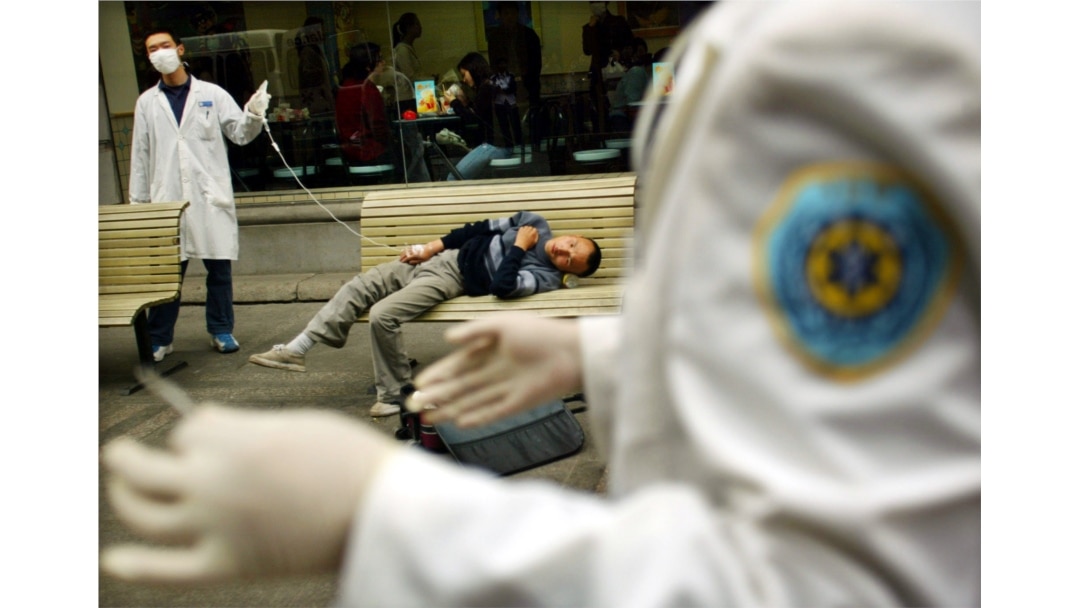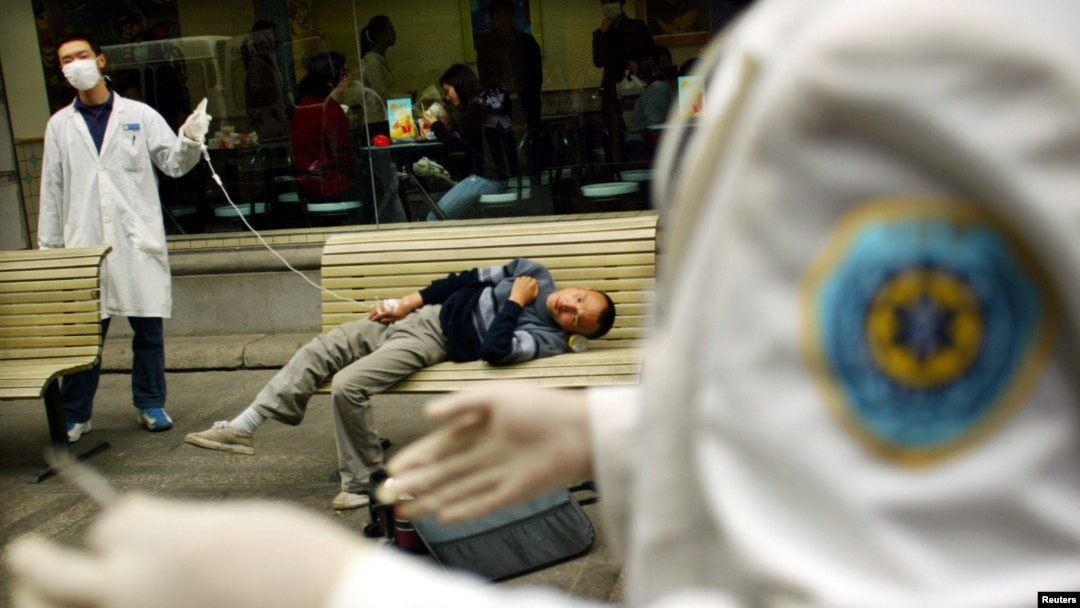
Paramedics tend to a man suspected of suffering from severe acute respiratory syndrome (SARS) after he collapses in Wuhan, China.
When this photo was taken on April 29, 2003, the world was in the midst of what threatened to become the first pandemic of the 21st century. SARS was a mysterious new coronavirus that killed some 10 percent of people it infected, mostly as a result of patients’ lungs clogging with fluid.

Civet cats being sold for meat in a market in Guangzhou in southern China.
In late 2002, SARS began its deadly spree after a coronavirus that is thought to have thrived in bats infected a civet cat, which in turn infected a person in southern China. Viruses can be passed from animals to people through inhaling an animal’s breath, eating food contaminated with animal feces, or exchanging bodily fluids -- as might happen when a butcher works with a cut hand.
A horseshoe bat. The SARS coronavirus is believed to have originated from this bat species before jumping to civet cats, then a person: patient zero.
Such “spillover infections” between species are commonplace, but the coronavirus that infected SARS patient zero in 2002 developed a trick that could wreak global havoc: the ability to jump easily between humans.
Security guards rush to stop a photo being taken outside a Beijing hospital in April 2003.
As dozens, then hundreds, of people in China were stricken down by the frightening new disease, the country’s ruling Communist Party began a Chernobyl-like cover-up of the unfolding crisis. Doctors were muzzled, and travel continued unchecked.
The Metropole Hotel in Hong Kong, where SARS began its global spread.
On February 21, 2003, mainland Chinese doctor Liu Jianlun, who had secretly been treating patients of the disease that would become known as SARS in Guangdong, traveled to Hong Kong to attend a wedding. After he checked into a room on the Metropole’s ninth floor, a fever Liu had been struggling with worsened. By the time he admitted himself into a nearby hospital with advanced symptoms of the new virus, several tourists staying at the Metropole had been infected, possibly as a result of Liu vomiting in a corridor. He died on March 4 after admitting to doctors that he had been dealing with the strange viral outbreak in mainland China.
A woman mourns a Hong Kong health-care worker who contracted SARS and died in May 2003 after the virus spread from the Metropole Hotel through several hospitals in the territory.
Hong Kong authorities moved swiftly to attempt containment of the outbreak, but by the time the alarm had been raised, several infected Metropole guests had checked out and unwittingly carried the coronavirus to their respective home countries.
A Canadian man outside a clinic for SARS patients in Toronto in March 2003.
One elderly woman left the Metropole and flew home to Canada on February 23, greeting her son with a hug. In less than three weeks, both were dead and Canada had become one of the world’s SARS hot spots.
Medical workers disinfecting the grounds of a hospital near Hanoi, Vietnam, in April 2003.
Metropole hotel guests from Vietnam and Singapore also carried the virus back to their home countries, sparking fresh SARS outbreaks and further global spread, as well as some drastic containment measures. By June 2003, at least 774 people had been killed by the virus. And then it stopped.
Professor John Oxford, emeritus professor of virology at the University of London and one of the world’s leading experts on infectious diseases.
Virology Professor John Oxford tells RFE/RL the reason the 2003 SARS outbreak fizzled out with less than 1 percent of the deaths of the COVID-19 outbreak so far is largely down to luck.
"I think the two viruses are very different," Oxford says. "We were very lucky in this regard with SARS in 2003. It was nothing like as spreadable as [the COVID-19 coronavirus]." And with strict containment measures enacted in most of the countries where it appeared, he says, "in the end it ran out of people to infect, it just ran out of steam."
France’s Arc de Triomphe stands above deserted streets on April 1, 2020. The current coronavirus pandemic has spread throughout the world, killed more than 100,000 people, and shut down huge segments of the world’s economy.
Oxford says it’s difficult to know yet why the coronavirus responsible for the current COVID-19 pandemic is able to spread so easily: “Why do daschunds have short legs, why do greyhounds have long legs? It’s evolution. [The new coronavirus] has turned out to be a fast spreader, causing a lot of asymptomatic infections, causing some deaths and so on. It has different characteristics.”
Spanish soldiers disinfect a marketplace in Pamplona on April 8, 2020.
A recent Chinese study suggests the new virus’s terrible success may be down to its ability to leap from person to person before symptoms are felt, or as Professor Oxford points out, from people unknowingly infected who never suffer its symptoms. In contrast, SARS patients in 2003 were most contagious only once they were suffering under the full misery of the disease, giving health workers time to isolate the infected patient.
A COVID-19 patient wearing a snorkel mask fitted to a ventilator in a hospital near Paris on April 1, 2020.
Whatever is eventually confirmed to be the reason for the new coronavirus’s wind-like spread around the world, Oxford says the virus clearly has more cunning behavior than the more lethal but less contagious SARS coronavirus of 2003 and adds, "I suspect it will stick with those characteristics."


